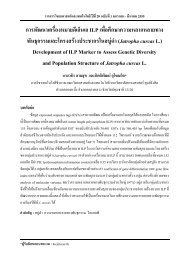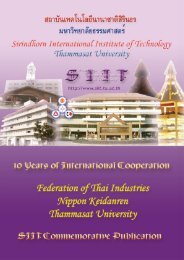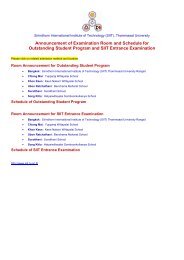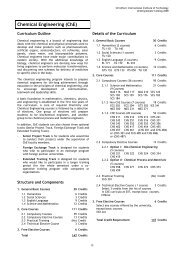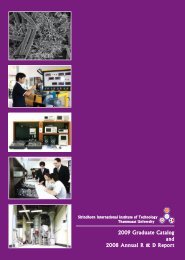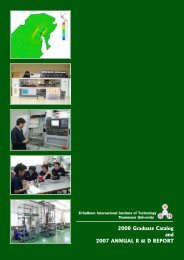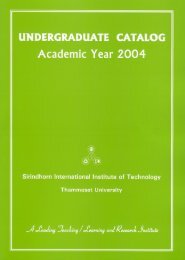2006 Graduate Catalog and 2005 Annual R & D Report - Sirindhorn ...
2006 Graduate Catalog and 2005 Annual R & D Report - Sirindhorn ...
2006 Graduate Catalog and 2005 Annual R & D Report - Sirindhorn ...
You also want an ePaper? Increase the reach of your titles
YUMPU automatically turns print PDFs into web optimized ePapers that Google loves.
<strong>2006</strong> <strong>Graduate</strong> <strong>Catalog</strong> <strong>and</strong> <strong>2005</strong> <strong>Annual</strong> R & D <strong>Report</strong><br />
<strong>Sirindhorn</strong> International Institute of Technology (SIIT)<br />
Dr. Pruettha Nanakorn<br />
Associate Professor<br />
B.Eng. (1 st Class Honors) in Civil Engineering, Chulalongkorn University, Thail<strong>and</strong><br />
M.Eng. in Structural Engineering, Asian Institute of Technology (AIT), Thail<strong>and</strong><br />
D.Eng. in Civil Engineering, The University of Tokyo, Japan<br />
Areas of Specialization: Fracture mechanics; Computational mechanics; Finite element analysis;<br />
Meshless methods; Structural optimization.<br />
Research Interests:<br />
Analysis of Cohesive Crack Growth by the<br />
Element-free Galerkin Method<br />
In this research, the Element-Free Galerkin (EFG)<br />
method is extended to include nonlinear behavior of<br />
cohesive cracks in 2D domains. A cohesive curved<br />
crack is modeled by using several straight-line<br />
interface elements connected to form the crack. The<br />
constitutive law of cohesive cracks is considered<br />
through the use of these interface elements. The<br />
stiffness equation of the domain is constructed by<br />
directly including, in the weak form of the global<br />
system equation, a term related to the energy<br />
dissipation along the interface elements. Using the<br />
interface elements in conjunction with the EFG<br />
method allows crack propagation to be traced easily<br />
<strong>and</strong> without any constraint on its direction.<br />
Structural Design Optimization by Genetic<br />
Algorithms<br />
When designing structures, engineers have to<br />
consider not only the load-carrying capacity of the<br />
structures but also the cost to construct them.<br />
Designs that use smaller amounts of materials are<br />
preferable, given that the construction methods do not<br />
become impractical or too expensive. To achieve this<br />
goal, many optimization techniques have been<br />
employed in structural design, each of which has<br />
strong <strong>and</strong> weak points. Important characteristics of<br />
the structural design optimization problems are 1) the<br />
solution we seek is the global optimal solution, 2) the<br />
design variables are discrete. These two major<br />
characteristics suggest that Genetic Algorithms could<br />
be good choices. In this study, an appropriate<br />
optimization technique for structural design based on<br />
the Genetic Algorithms will be proposed.<br />
Dr. Somnuk Tangtermsirikul<br />
Professor<br />
B.Eng. (Honors) in Civil Engineering, Chulalongkorn University, Thail<strong>and</strong><br />
M.Eng. & D.Eng. in Civil Engineering, University of Tokyo, Japan<br />
Areas of Specialization: Modeling of concrete behavior; Durability of concrete; Special concrete; Use of<br />
wastes <strong>and</strong> recycled materials in cement <strong>and</strong> concrete; Repair <strong>and</strong> maintenance of concrete structures.<br />
Research Interests:<br />
Performance Based Analysis <strong>and</strong> Design of<br />
Concrete Mix Proportions<br />
Simulation models for predicting time <strong>and</strong><br />
environment dependent properties of concrete are<br />
studied. At present, the studied properties are<br />
workability, bleeding, strength, thermal cracking,<br />
autogeneous <strong>and</strong> drying shrinkage, cracking<br />
resistance carbonation, chloride induced corrosion,<br />
<strong>and</strong> sulfate resistance. Computer software is being<br />
developed for analysis <strong>and</strong> design purposes to obtain<br />
mix proportions of concrete with the required initial<br />
<strong>and</strong> long-term performances.<br />
Use of Wastes <strong>and</strong> By-Products in Concrete<br />
Studies on the properties of concrete with various<br />
wastes <strong>and</strong> by-product materials are conducted. The<br />
materials are: fly ash, bottom ash, limestone powder,<br />
lime ash, blast furnace slag, etc. Optimizing the use<br />
of these materials is the aim of this project.<br />
Special Concrete<br />
Various types of special concrete are studied with the<br />
aim to make proper use of local materials. Mix design<br />
processes in the forms of software <strong>and</strong> design charts<br />
are being developed. In addition to the mix design,<br />
some st<strong>and</strong>ard guidelines are being established. The<br />
studied types of special concrete are; self-compacting<br />
concrete, zero-slump concrete, low-heat concrete <strong>and</strong><br />
sulfate-resisting concrete, etc.<br />
Maintenance of Concrete Structures<br />
Inspection of existing concrete structures located in<br />
various places is being conducted with the aim to<br />
develop a proper inspection program for Thail<strong>and</strong>.<br />
17




